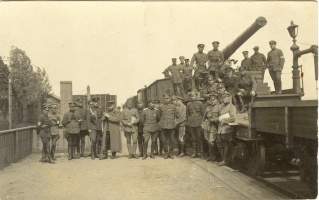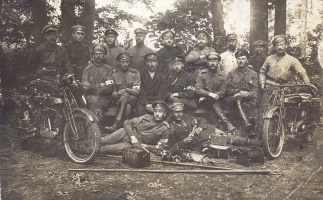Leading up to the Battle↑
After the liberation of Riga on 22 May 1919 from the Bolshevik forces, the Baltic Germans’ land defence forces (Baltische Landeswehr) and the Iron Division – an armed unit that consisted of German volunteers – were ordered to advance north and north-eastward in order to attack the 2nd Division of the Estonian army from the rear. At that time, a considerable part of Northern Latvia had already been liberated by the joint troops of the Estonian army and the Northern Latvian Brigade, which was politically subordinate to Kārlis Ulmanis’ (1877-1942) Latvian Provisional Government. On 16 April 1919, the Germans overthrew Ulmanis’ government in Liepāja and established the puppet government headed by Andrievs Niedra (1871-1942). Still, the coup d’etat was only partially successful, as Ulmanis’ government found refuge on board ship under protection of the British Navy. On 1 June 1919, the Northern Latvian Brigade reached Cēsis.
The aim of the German leadership and their forces’ commanding officer, General Rüdiger von der Goltz (1865-1946), was to create a military base for their troops in the Baltics to prepare for future war against the Allies; this idea was reinforced by the complicated process of the Paris Peace Conference. The Germans came up with a plan to imperceptibly incorporate the Iron Division units into the Landeswehr, thus establishing the “Latvian troops” under the Niedra government’s command.
The First Stage↑
On 3 June 1919, Landeswehr representatives arrived in Cēsis. Estonian commander-in-chief, General Johan Laidoner (1884-1953), issued an ultimatum demanding that the Germans stop their advance and withdraw their forces southwards, leaving the railway between Ieriķi and Gulbene under Estonian control. The German forces did not accept the ultimatum and Niedra’s government decided to direct the German forces to Valmiera and Valka to end the “Estonian occupation”. When an Estonian armoured convoy moved out on 5 June 1919 to monitor compliance with the Estonian demand, the Germans tried to ambush it. The attack was unsuccessful, but the convoy was nonetheless forced to withdraw to Cēsis.
On 6 June 1919, the Landeswehr’s units attacked the Northern Latvian Brigade Cēsis 2nd Regiment, whose formation was not yet completed, in the village Līvi. The Latvians were supported by fire from the Estonian armoured convoy, but were still forced to retreat to the River Rauna. The Germans captured Cēsis. On 7 June 1919, this Latvian regiment was replaced by an Estonian regiment. The Estonian counterattack on 8 June 1919 was repelled and the German command demanded Estonian withdrawal to the line Ainaži-Valka-Izborsk.
The Allies took initiative and organized negotiations in Cēsis on 10 June 1919, which resulted in signing an armistice. The Allied Powers in Paris issued a decision prohibiting German forces’ further movement towards Estonia. At the same time, the Entente took responsibility to supply the Baltic States armies. Nevertheless, the Germans rejected the demand and, taking advantage of certain American support, started to incorporate the Iron Division into the “Latvian troops”.
The Second Stage↑
The ceasefire lasted until the morning of 19 June 1919, when the Landeswehr assumed the offensive in the direction of Limbaži. On 20 June 1919, the Iron Division units captured Lielstraupe. On 21 June 1919, the Germans broke through between the 2nd Latvian and 3rd Estonian Infantry Regiments. However, the Estonians managed to stop their offensive.
The German forces had approximately 9,000 soldiers, sixty-six guns, and 520 machine guns, while the joint Estonian-Latvian forces had 7,000 soldiers, three armoured trains, thirty-two guns, and 250 machine guns and automatic rifles. Early on 22 June 1919, the Estonian-Latvian forces launched a counterattack. The Estonians managed to divide the German advanced guard units, forcing the Germans to retreat. The Iron Division tried unsuccessfully to save the situation since the Estonian cavalry units already had reached their rear. Consequently, on the morning of 23 June 1919, the Estonian and Latvian units entered Cēsis. The Estonian 9th Infantry Regiment launched a simultaneous attack on German positions in the vicinity of Limbaži, forcing them to retreat. Germans tried to entrench in the World War I fortifications by Inčukalns but had to leave these positions on 26 June 1919. On 27 June 1919, Germans retreated to the line of the River Jugla, not far from Riga.
By early July 1919, the Estonian forces had entered Daugavgrīva, Mangaļsala and Vecmilgrāvis (now Riga city suburbs) and the Estonian 3rd Division continued their advance by launching artillery bombing of the city, during which dozens of civilians were killed. This created panic among the German forces and the Baltic German population of Riga, leading to a speedy evacuation. Already on 26 June 1919, Niedra’s government had left the city and ceased all activities.
Consequences↑
During the Battle of Cēsis, all sides suffered losses. The Estonian army had 110 killed and 405 wounded and missing soldiers; the Northern Latvian Brigade had thirteen killed and forty-three wounded soldiers; and the Landeswehr had sixty-five killed and fifteen missing soldiers. The losses among the soldiers of the Iron Division are not known but were likely significant as well.
Further warfare was affected by the Entente position. On 23 June 1919, the Germans left Liepāja, complying with their demand. On 30 June 1919, the representatives of Allied missions in Liepāja mandated Emmanuel du Parquet (1869-1933), chief of the French mission, to organise armistice talks. The Allies demanded a ceasefire. On 1 July 1919, du Parquet acted as a mediator in negotiations between the German forces and the Estonian military command. The armistice was finally signed on the morning of 3 July 1919. The treaty provisions required that hostilities be suspended and that the German forces withdraw from Latvia at the earliest opportunity. Their troops had to be withdrawn from the right bank of the River Daugava, Riga and its vicinity by the evening of 5 July 1919. Germans were not allowed to obstruct communication in the Latvian regions of Kurzeme and Zemgale. Estonian forces had to halt at the site they had stopped on 3 July 1919, and Allies were to be responsible for establishing the provisional Riga city governance.
As a result of the Battle of Cēsis, Ulmanis’ Provisional Government regained power in the part of the country already liberated from the Red Army. On 6 July 1919, the Northern Brigade entered Riga, and soon Ulmanis’ government returned to the capital. The Latvian army was established on 10 July 1919. The armistice stipulated that the Landeswehr be regrouped and its German volunteers withdrawn; it was to become part of the Latvian army. The British Lieutenant Colonel Harold Alexander (1891-1969) was appointed its commander. The Landeswehr later fought against the Red Army in Eastern Latvia.
Ēriks Jēkabsons, University of Latvia
Section Editor: Piotr Szlanta
Selected Bibliography
- Andersons, Edgars: Latvijas vesture, 1914-1920 (The history of Latvia, 1914-1920), Stockholm 1967: Daugava.
- Penik̦is, Mārtin̦š: Latvijas atbrīvošanas kar̦a vēsture, 1. dala (The history of the War of Liberation, Part I), Linkolnā 1961: L.A.B. Daugavas Vanagi A.S.V. uzdevumā D.V. apvienība.
- Pumpurin̦š, Tālis: Kad lielgabali dziedāja Līgo. Atmin̦u un rakstu krājums par Cēsu kaujām 1919. gada (The memoirs and articles about the battles of Cēsis in 1919), Cēsis 1994: Cēsu muzeju apvienība.
- Valmieras kājnieku pulks (ed.): Valmieras kājnieku pulka vēsture, 1919-1929 (The history of Valmiera’s regiment, 1919-1929), Lincoln 1976: Valmieras kājnieku pulka bijušie kar̦avīri.









